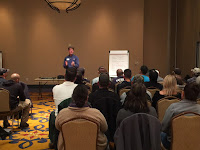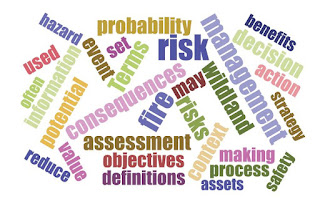 |
| John Prendergast, NIMO Safety Officer providing background on risk mgmt |
 |
| Leadership panel discussion |
On Monday afternoon a leadership panel discussion was held, with representatives from the R3 Regional Office, Lincoln NF Supervisor's Office, District Ranger, and a Forest FMO. This allowed participants to ask questions, of their leadership, and provide comments in regards to risk management and how they see it changing the way they do business on the Forest.
 |
| Supervisor's Office discussion group |
On days 2-3, students were emerged into the newly developed "Risk Informed Decision-making". This session allows the individuals to work through an incident using a variety of risk assessment tools and from three various decision making positions (strategic, deliberate, and time-critical).
 |
| Guadalupe Ranger District group |
The students were broken up based on their organizational affiliation (Supervisor's Office/District Office) and were given background information on the scenario that they were to work through. During the Strategic Risk Assessment portion (all of day 2), they were all asked to work and think like Agency Administrators. This sparked a lot of great discussions.
 |
| Smokey Bear Ranger District group |
 |
| Sacramento Ranger District group |
This was the first time that NIMO has put on both of these sessions (Introduction to Risk Management and Risk Informed Decision-making) at the same time. It was a long, but successful, three days. Currently, the session is geared toward a fire incident, however the message and tools can be utilized for all disciplines and projects within the Forest Service.
There is risk in everything we do; assessing it is how we can lower the potential for a bad outcome.

































